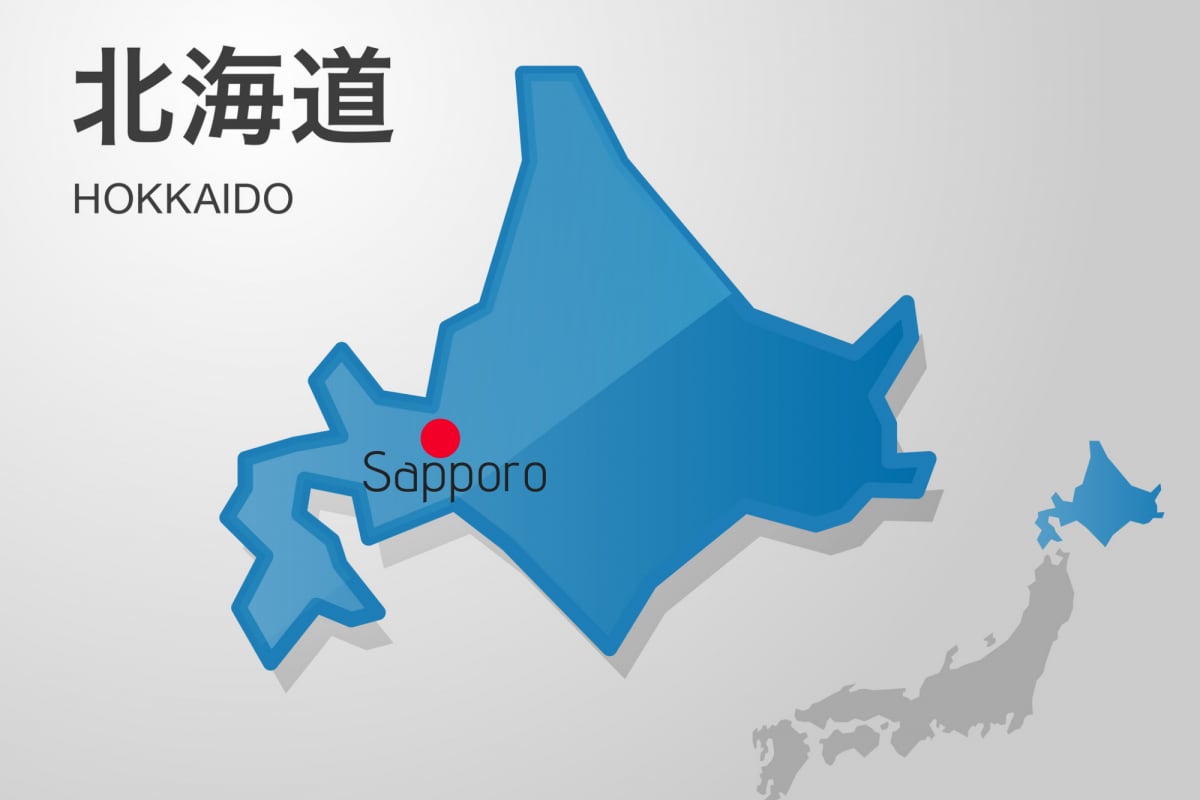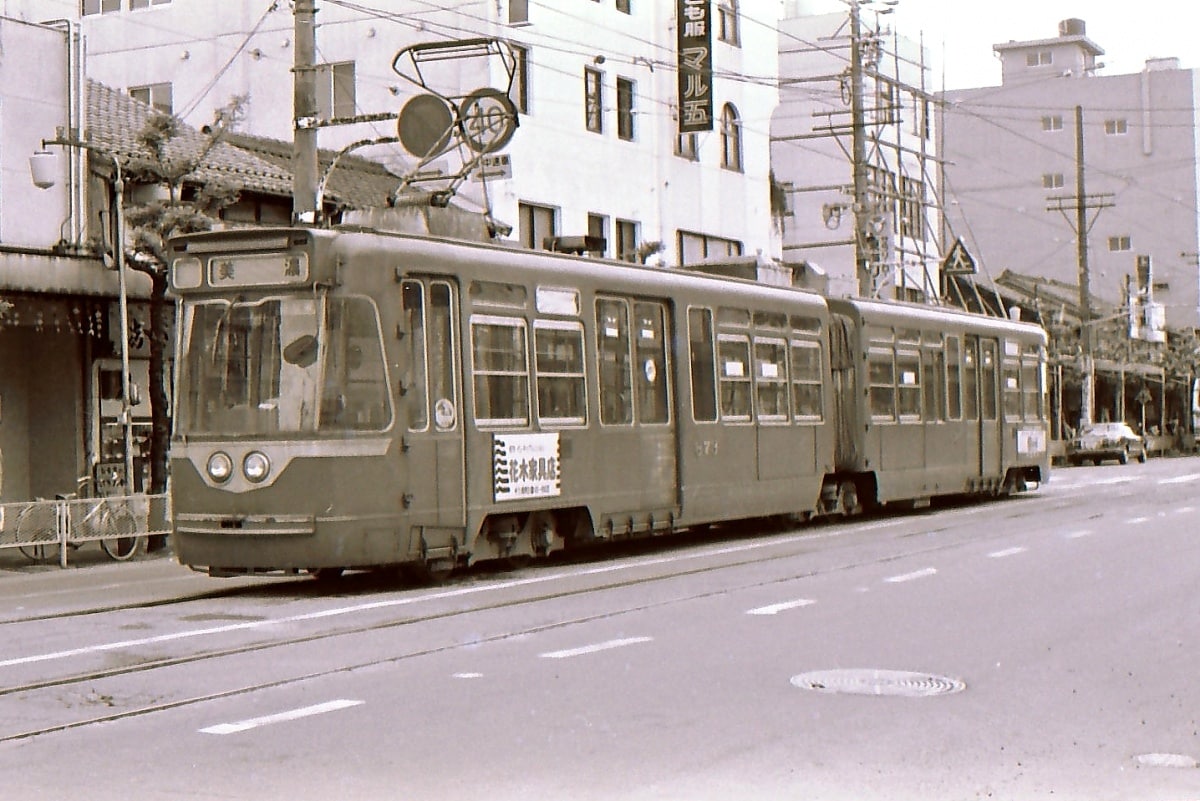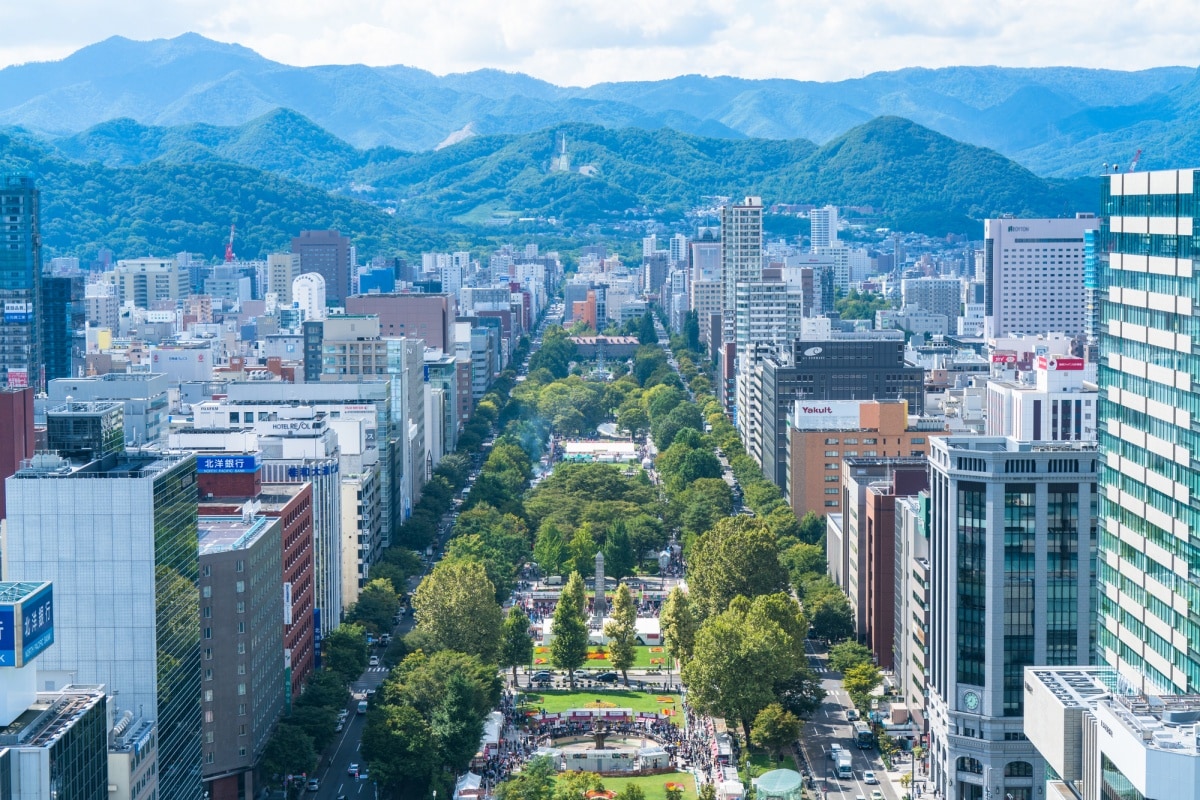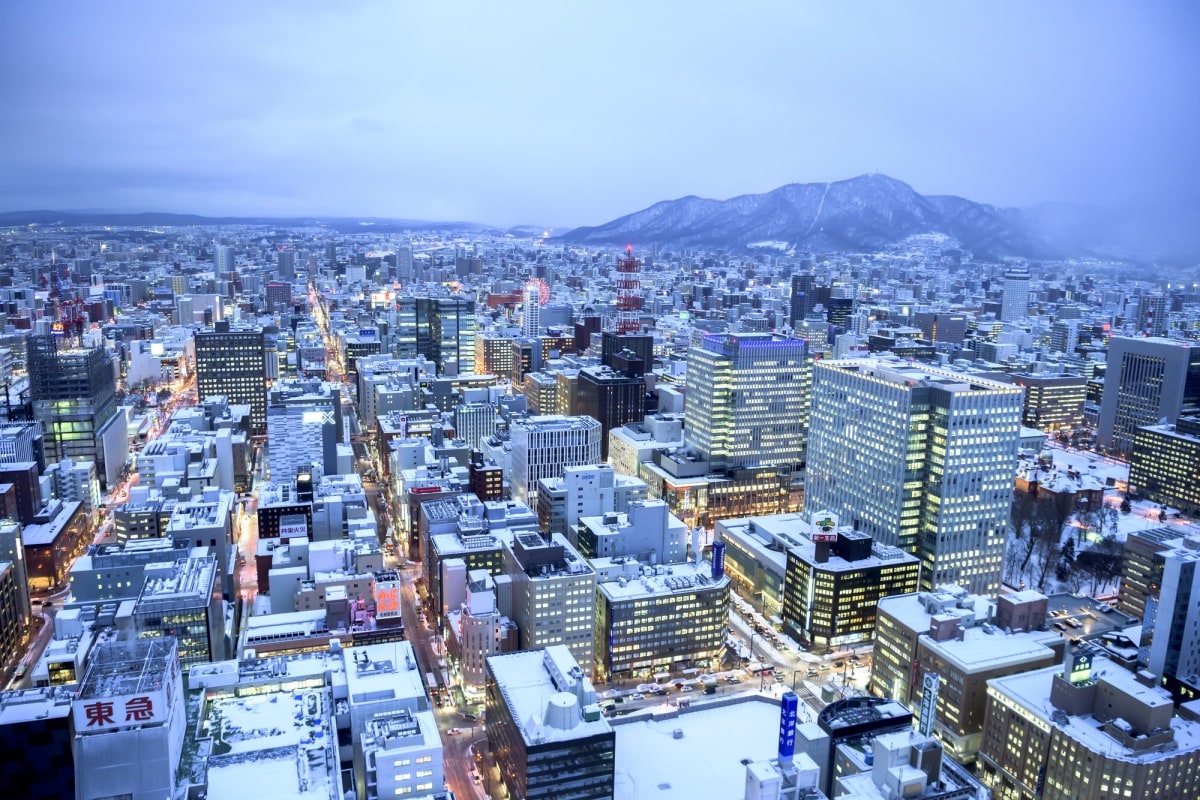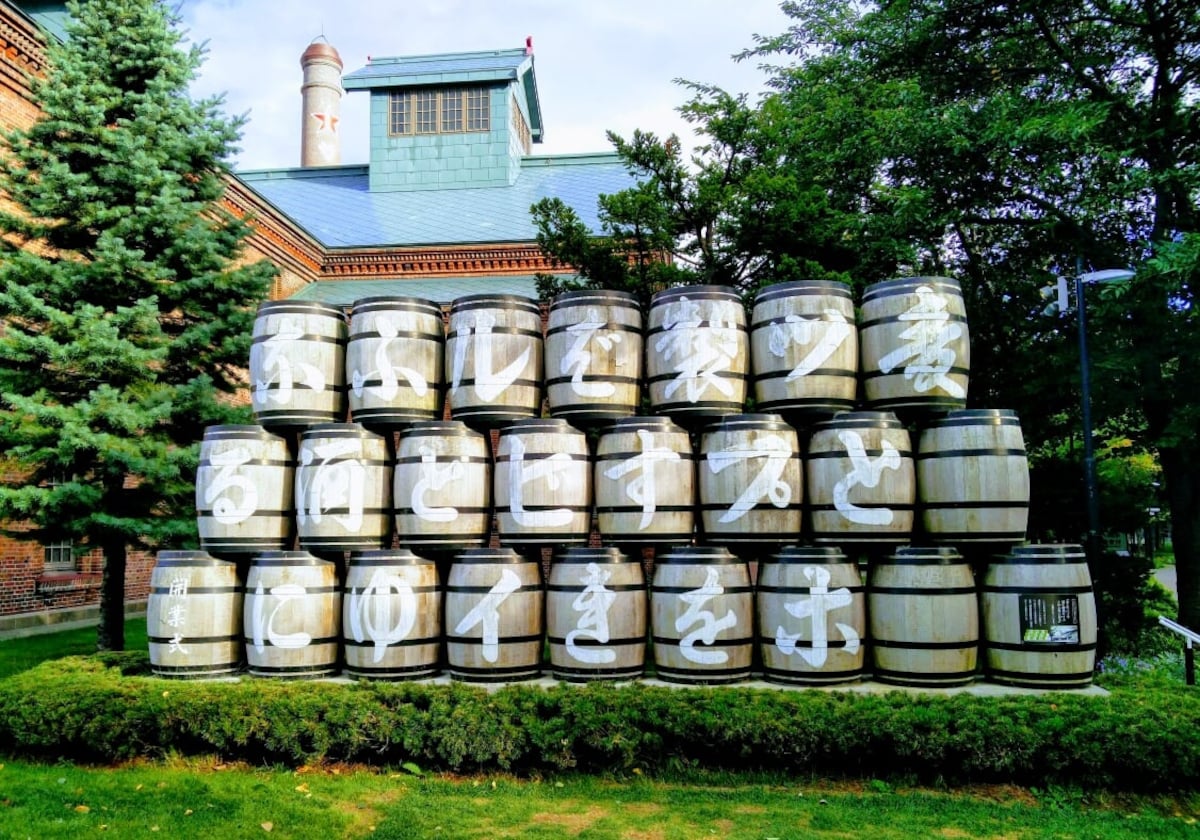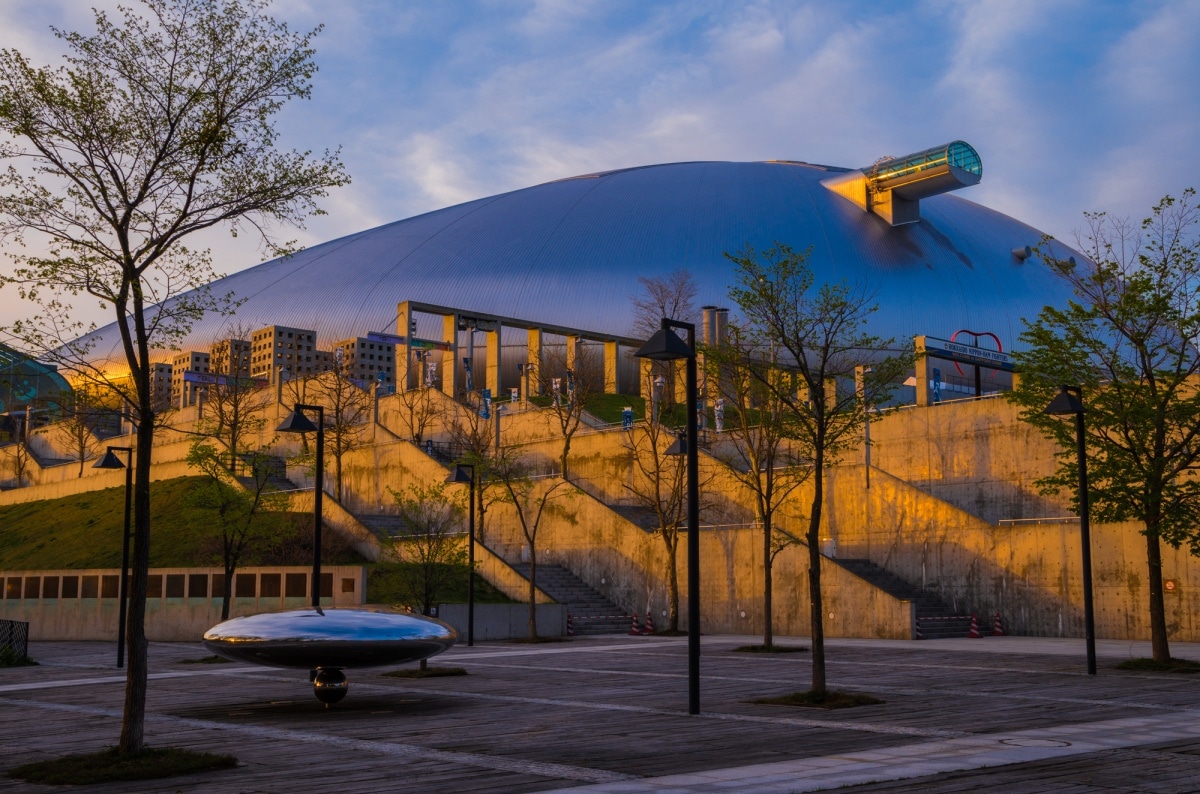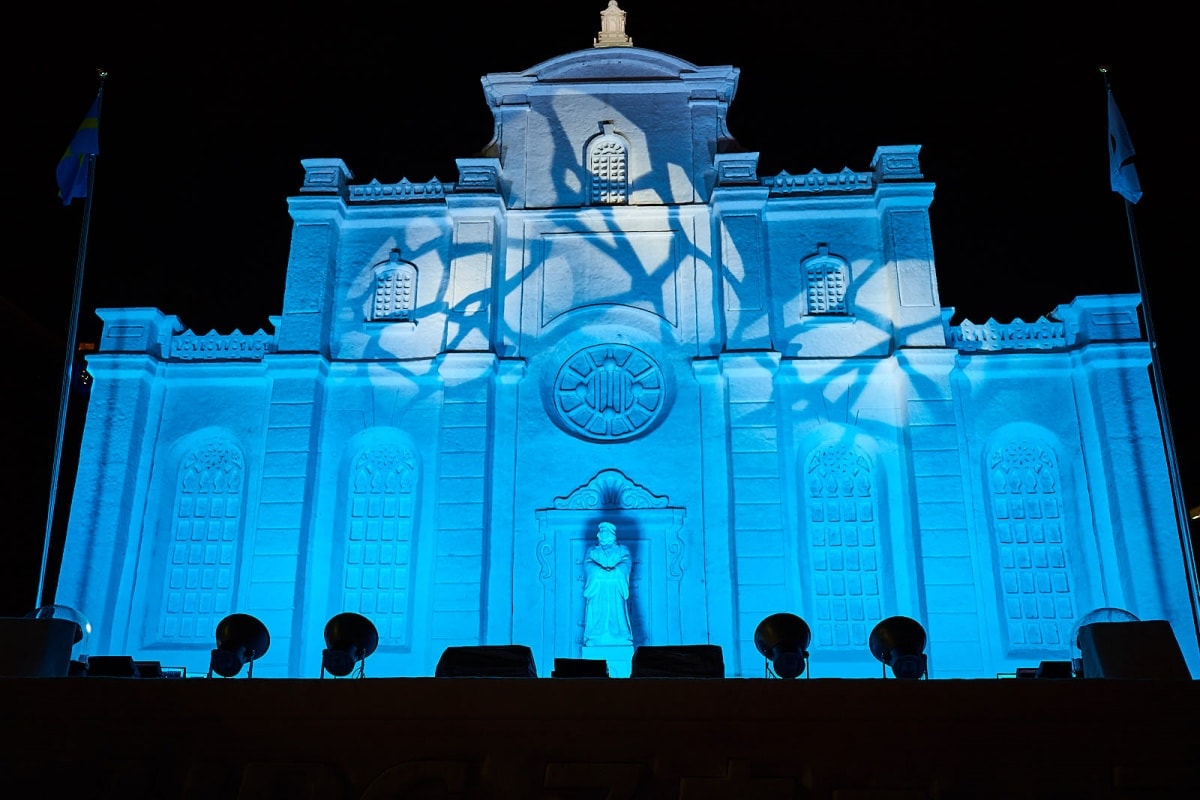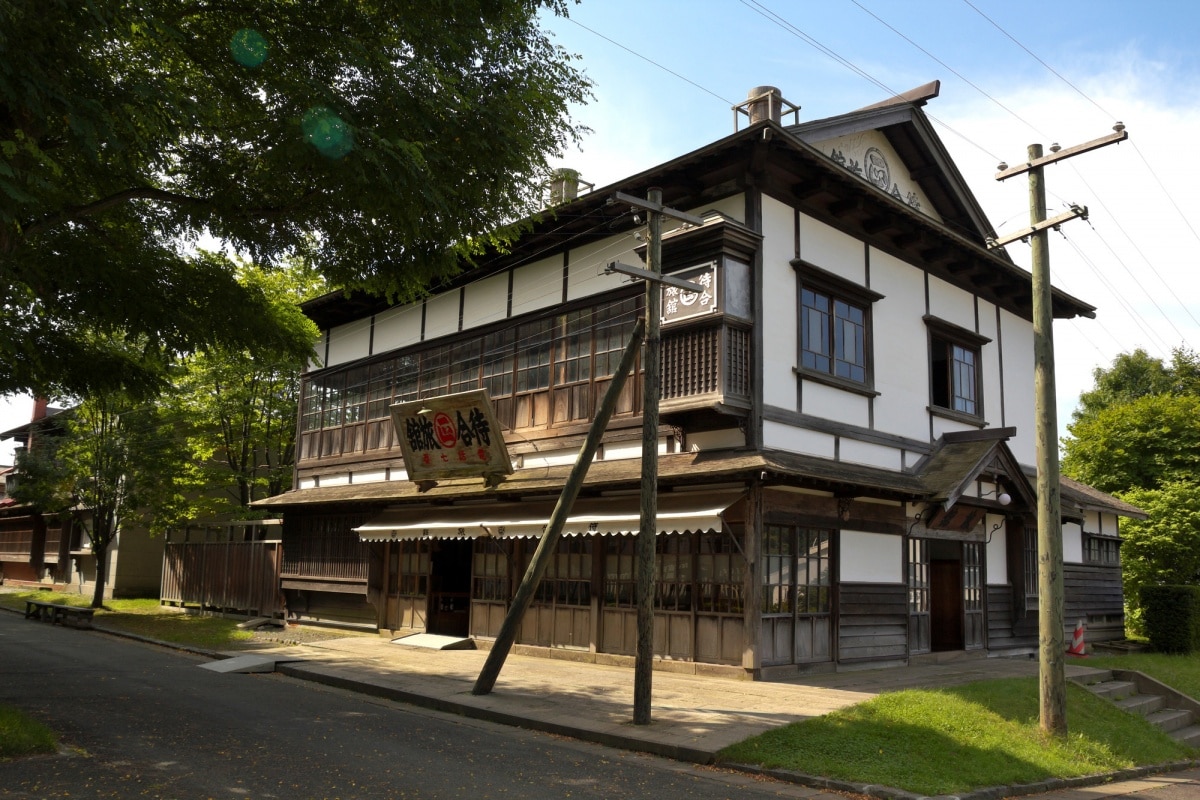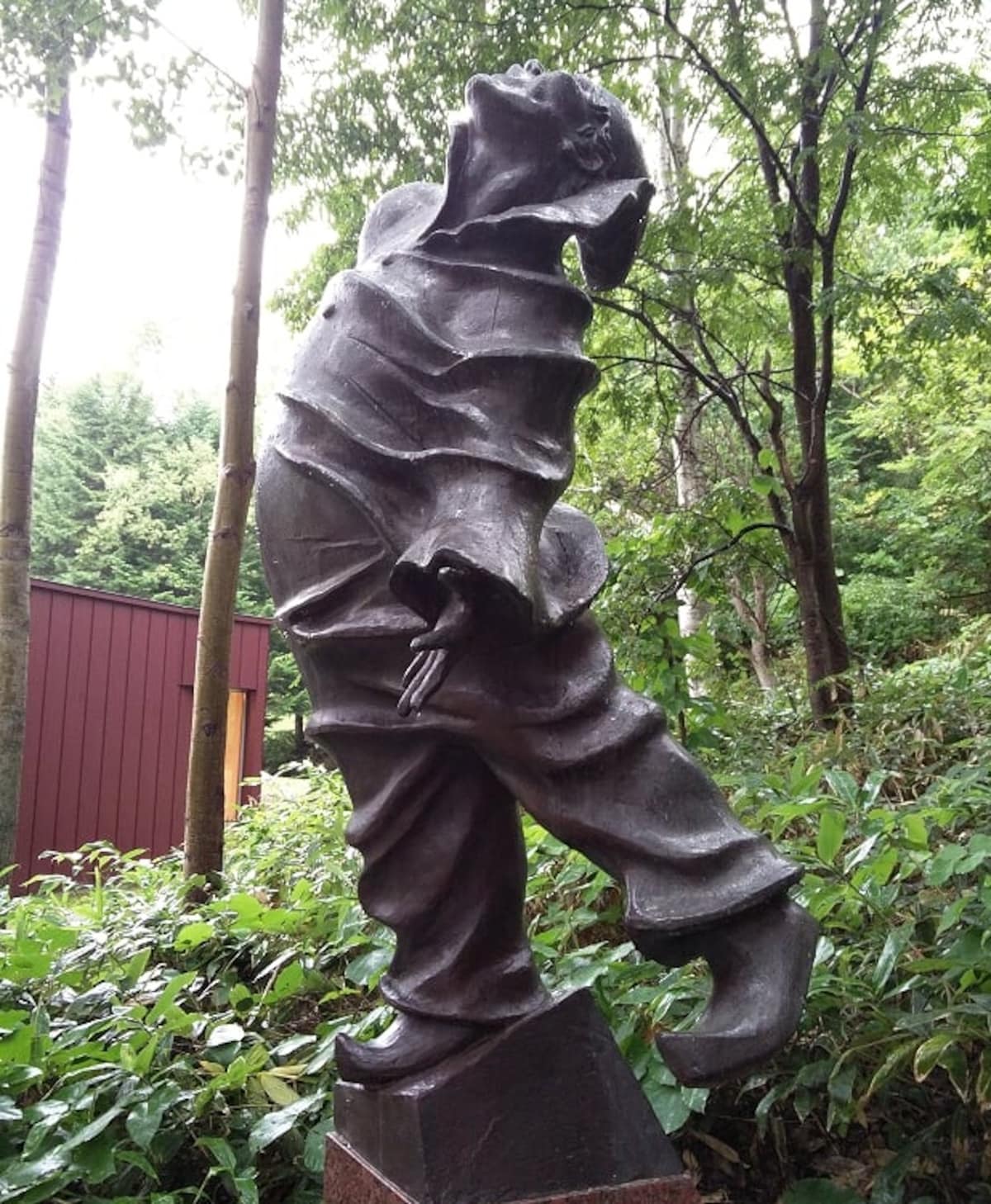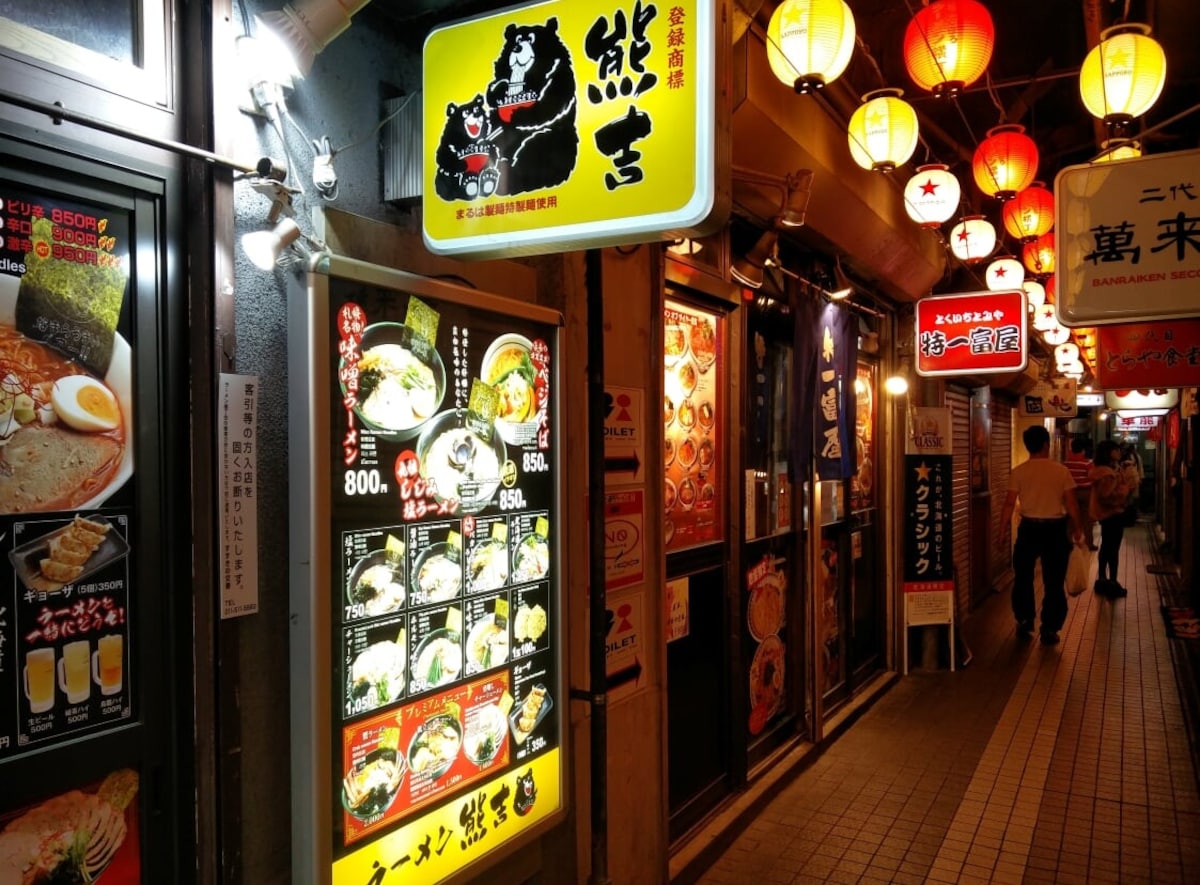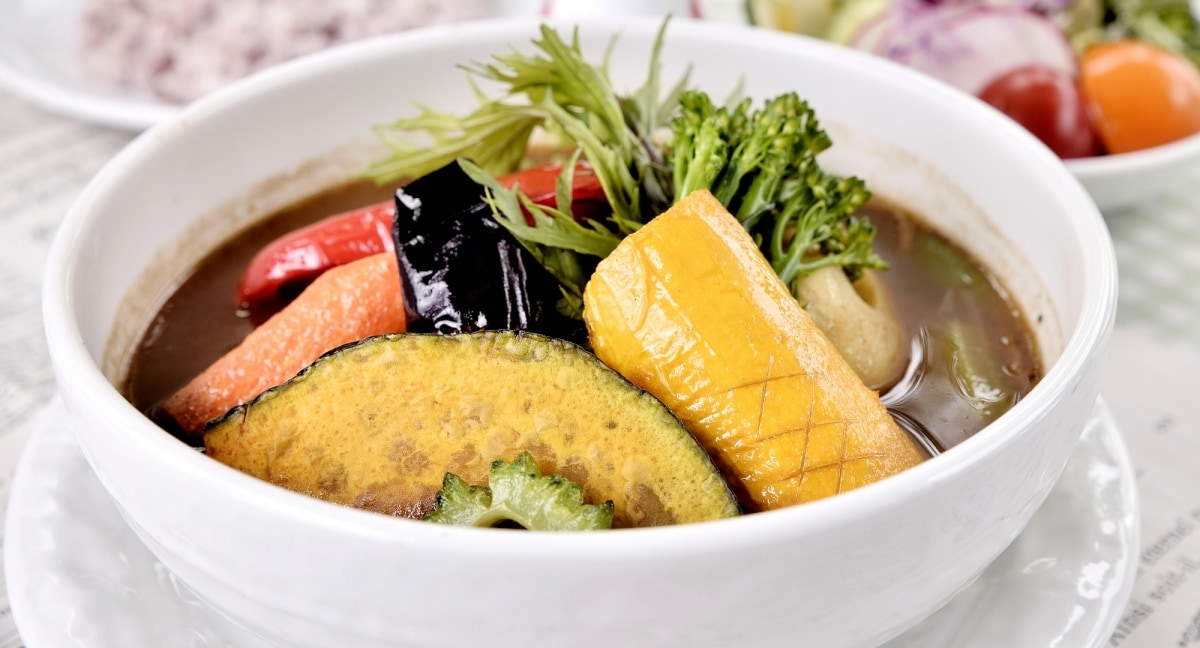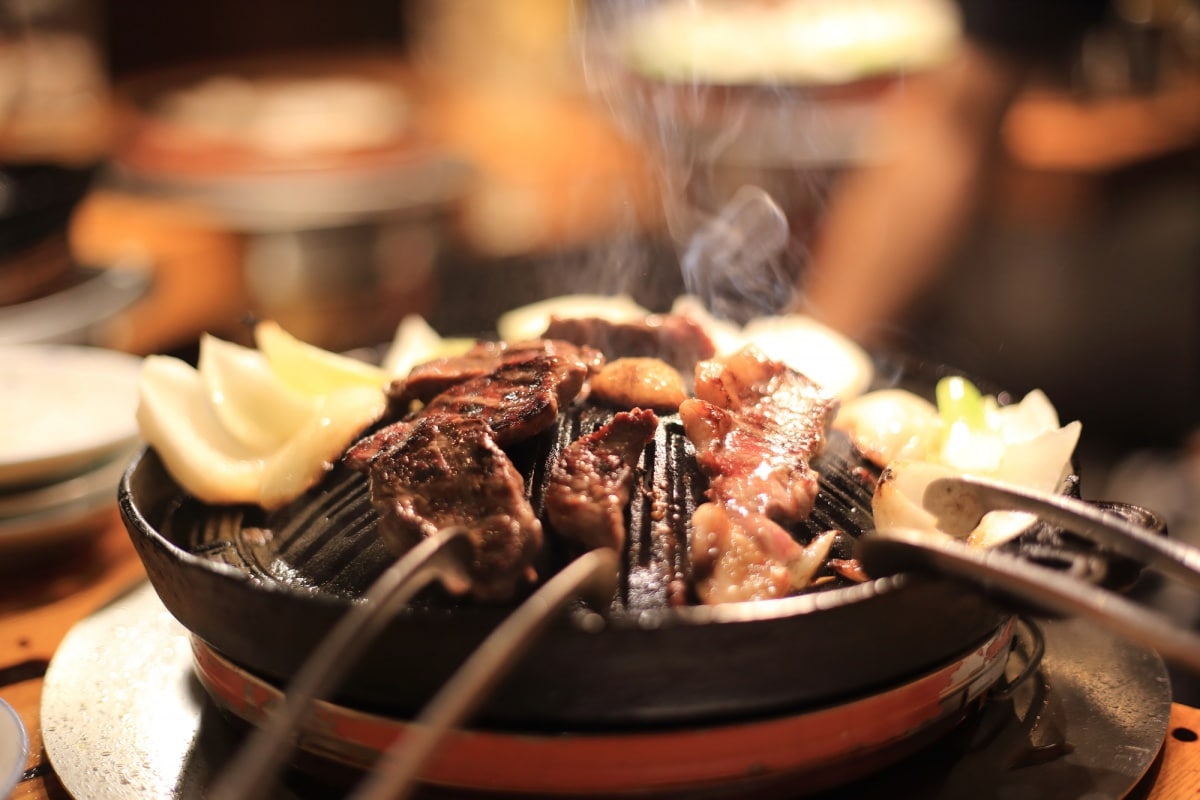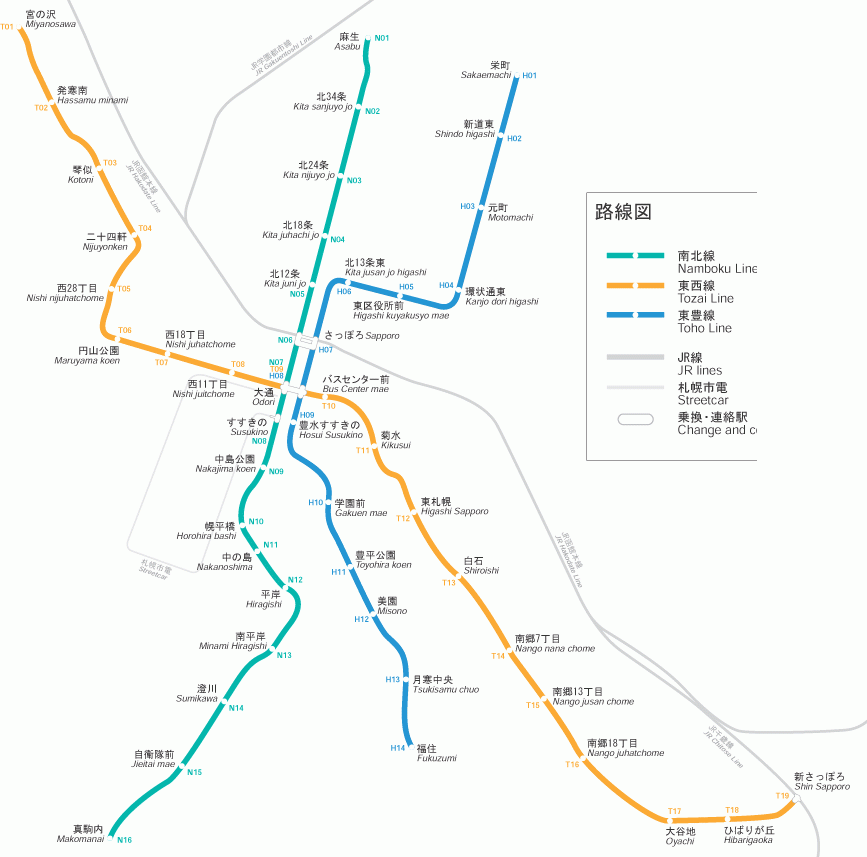All About's Guide to Sapporo
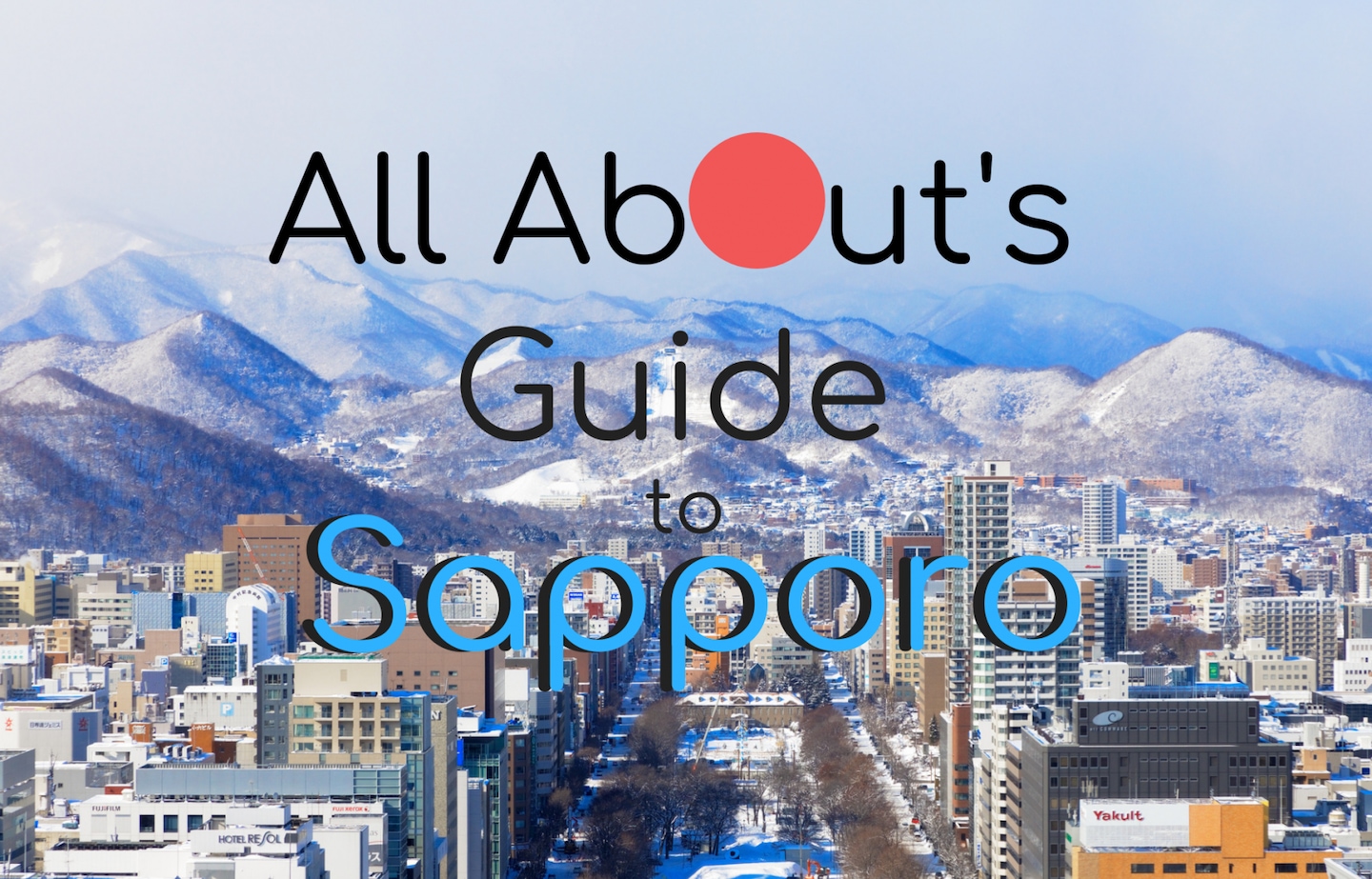
Japan's northern island Hokkaido is known for its breathtaking nature, stunning vistas and world-renowned ski resorts. The capital city, Sapporo, is worth visiting no matter the season! Its bracing, snowy winters and wonderfully temperate summers combine with unique regional culture to create a tourist destination as interesting as any in Japan.
By DavidKey Sapporo Facts
The city of Sapporo (札幌) is the capital of Hokkaido (北海道), Japan's northernmost island and largest prefecture. It's separated from Japan's main island, Honshu, by the Tsugaru Strait, but is connected by rail via the undersea Seikan Tunnel. Sapporo encompasses an area almost double the size of Tokyo, and is the fifth most populous city in Japan, with a population of some 1.96 million people.
Until the end of the Edo Period (1608-1858), Sapporo was scarcely more than a little fishing town in Japan's snowy north, and Hokkaido was known as Ezo. This fishing village, which sat on the Ishikari Plain, was populated mainly by the Ainu—the tribal people indigenous to Hokkaido. Although there are several theories as to its origin, it is agreed that it is from their native language that Sapporo derived its name. One theory is that the name comes from sari-poro-pe, which is a combination of "wetland," "wide" and "river." That description is especially fitting for the basin downstream from the Toyohira River, near Sapporo. The leading theory, however, is that it is derived from sap, which means "dry," and poro, which means "wide."
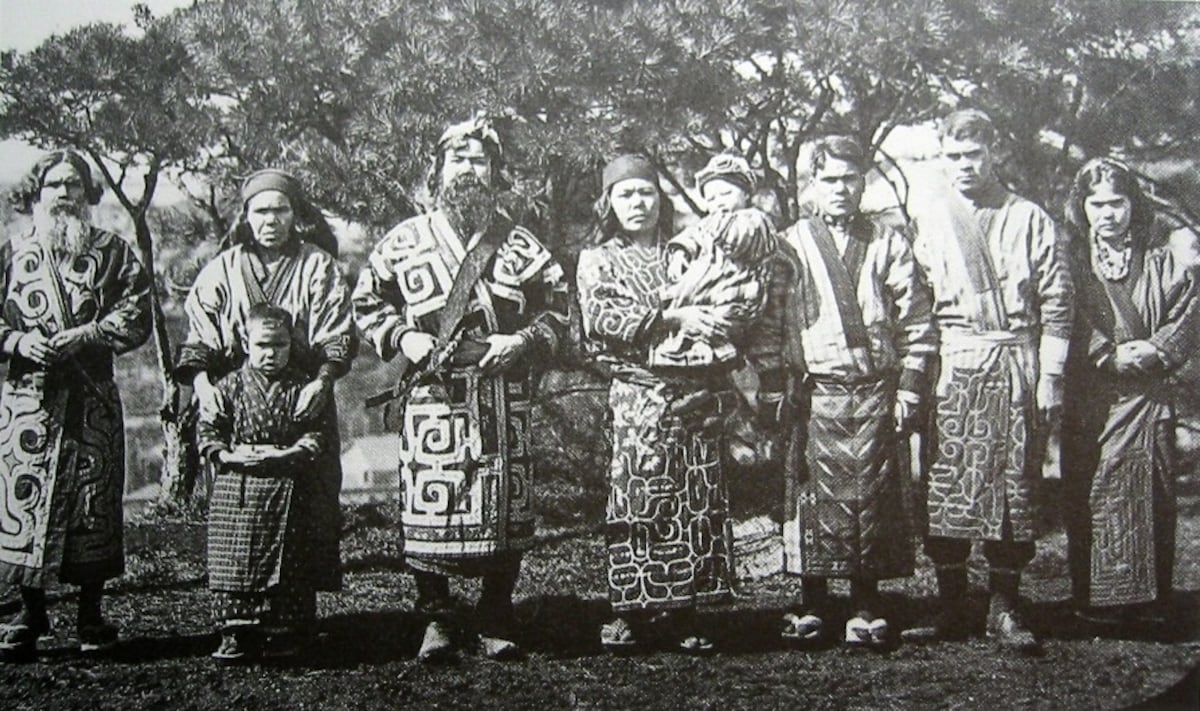
https://en.wikipedia.org/wiki/Ainu_people
Scholars theorize that the culture of the Ainu emerged after the Jomon Period, and was a blend of Satsumon culture from northern Japan and the hunter-gatherer culture that was prominent in the lands surrounding the Sea of Okhotsk. From the mid-1400s the Ainu periodically battled the mainland Japanese who expanded northward, until eventually falling under the control of the Japanese government in 1789 after defeat in the Battle of Kunasiri-Menasi.
Although the village that would become Sapporo was used as a trading post with the Ainu, the city itself was "born" during the Meiji Period (1868-1912) in 1869, when the government annexed the northern island and renamed it Hokkaido.
Over the next hundred or so years, Sapporo became the economic, governmental and cultural center of Hokkaido, which was eventually recognized as a full-fledged prefecture. Industry started to flourish in the 20th century with the creation of railways and road networks, which connected more remote parts of the island to its major city. Flour milling and paper making industries boomed, in addition to the roaring success of the acclaimed Sapporo Breweries beer company.
By 1972 Sapporo's population had surpassed one million, and by government ordinance it was officially designated Japan's northernmost city. That same year Sapporo hosted the 1972 Winter Olympic Games—a first not only for Japan, but also Asia—which gained the city global recognition.
Today Sapporo is a sprawling urban landscape comprised of 10 city wards that cover nearly 697 square miles (about 1,121 square kilometers). Despite its size and modernity it's also a rather picturesque city, nestled in the Toyohira River valley, full of greenery and surrounded by mountains. Combine this with its northern latitude and the extremes of its climate, and what you get is a true melting pot of activities and experiences throughout the year. It's easy to see why Hokkaido is among the top 10 most visited prefectures in the country.
Sapporo is best known as a winter wonderland, and since the city spends about 132 days a year covered in snow it's easy to see why. Winter in Sapporo is cold, with average temperatures around -7 degrees Celsius (or 19°F) in January. Snow can fall as early as October, and typically persists from early December to March. In February, Sapporo hosts its world-famous Snow Festival, where millions of visitors come to see the unbelievable snow and ice sculptures on display, created by contestants from around the world. For outdoorsy thrill-seekers, there's a winter resort located in the western mountains where you can ski and snowboard on some of the world's freshest powdered snow.
The frozen chill of Sapporo's winter slowly thaws into a cool spring in April, when flowers and late-blooming cherry blossoms take center stage. This is followed by a very mild summer (by Japanese standards) in which the temperature rarely exceeds 27 degrees Celsius (about 81°F)—what's more, they typically avoid the summer rainy season that envelopes the rest of the country. Autumn comes early, and the leaves fade to orange and brown as temperature slowly declines through the months of September and October.
Top 5 Sights
With so much seasonal variety in Sapporo, narrowing the best of the best down to a mere five is no easy feat. However, here are some sights that visitors absolutely should not miss!
1. Mount Moiwa
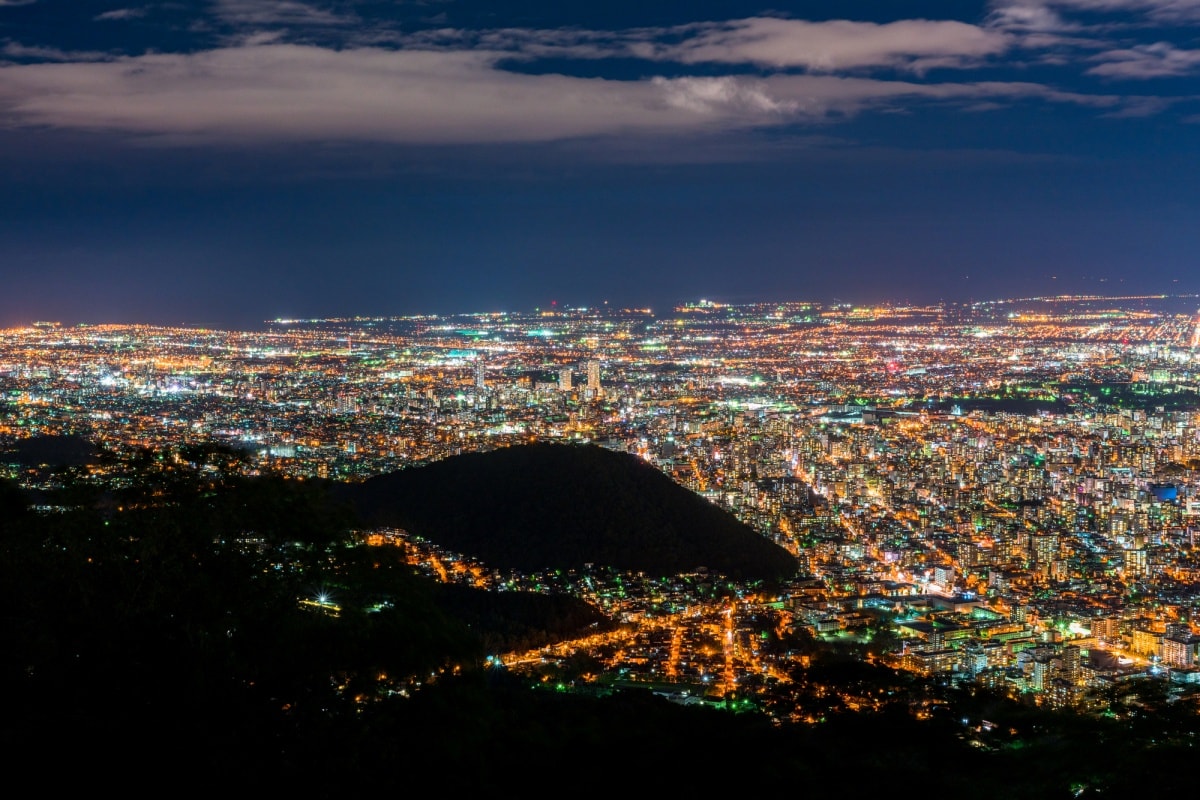
https://pixta.jp
Towering at 531 meters (about 1,742 feet) just a little west of the city, Mount Moiwa provides the best vantage point of the entire city, hands down. The peak of the mountain can be accessed via ropeway and cable car, which is ¥1,700 for a roundtrip. The view at night is particularly exceptional, and Mount Moiwa is open from 10:30 a.m. to 10 p.m., with last admissions 30 minutes before closing.
For the ambitious, it's also a relatively easy hike. Depending on your speed it can take up to three hours, and while the trail is a little steep at parts, it is a very beaten path. Like most mountains in Japan, there is a designated climbing season, and hiking is prohibited in the icier months of winter. No matter the season, be sure to bring proper hiking shoes. Take it from someone who's made the mistake of forgetting!
Regardless of which way you choose, when you reach the top you'll be greeted with an incredible view more than worth the trip! For the romantically inclined, the observation deck is also named a "Lover's Sanctuary," and is a popular proposal spot. With scenery like that, it's almost impossible for sparks not to fly!
Access: From Susukino Station, take the Sapporo Streetcar to the Ropeway Iriguchi Station. From there, a free shuttle bus or a short walk will take you to the Mount Moiwa Ropeway.
Address: 5-3-7 Fushimi, Chuo-ku, Minami, Sapporo 064-0942
2. Sapporo Beer Museum
Sapporo Breweries—the company behind the iconic Sapporo Draft and the premium Yebisu—is one of Japan's oldest, and one of the best selling Japanese beer brands around the globe. This museum offers a glimpse into the esteemed company's history. You can take a short self-guided tour through the museum for free, where lots of vintage artwork from the Sapporo Beer ads of yesteryear adorn the walls. The timeline of Sapporo's rise from obscurity to global beer powerhouse is recounted on displays throughout, with summaries in English, simplified Chinese and Korean. There is also a paid tour available (at ¥500/person) in Japanese only, during which visitors are guided through all three floors of the facility and treated to a tasting at the end.
Speaking of tastings, within the main building there is also the Star Hall tasting area, where you can sample some of their finest brews! A beer flight featuring three varieties costs ¥600, which is quite the bargain. Beyond the Star Hall there's also a dining area that includes a meat-and-beer-fueled biergarten, which captures the aesthetics and atmosphere of its German inspiration. Finish up your time with a visit to the museum shop, which offers exclusive goods you can't find anywhere else! It's open from 11:30 a.m. to 8 p.m., and is closed on Mondays and national holidays.
Access: The Sapporo Beer Museum is serviced by the Loop 88 Factory Line bus, which stops near Sapporo Station. Alternately, it's about a 25-minute walk from Sapporo Station itself.
Address: 9-1-1 Kita 7 Johigashi, Sapporo 065-8633
3. Susukino
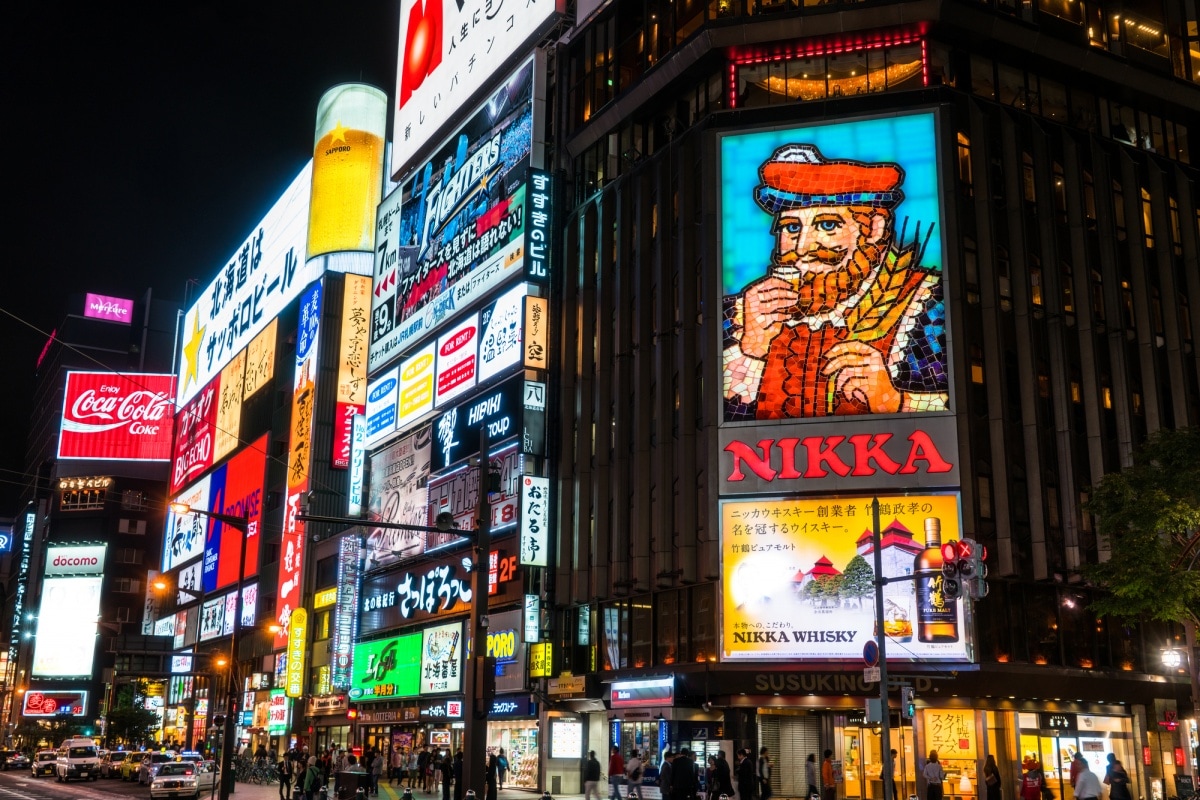
https://pixta.jp
Susukino is Sapporo's entertainment hub, and—like the crowded streets of Tokyo's Shinjuku neighborhood—is the image conjured when imagining nightlife in Japan. It boasts that it's the largest entertainment district north of Tokyo, and it draws in hordes of tourists annually.
Why? The area is chock-full of great eateries, from high-end sushi restaurants to the famous Ramen Yokocho (more on that later). Squeezed in between these you can find classy cocktail bars, smoke-filled izakaya and even "500 bars," establishments where ALL drinks are ¥500. There are also tons of different shops and stores, as well karaoke spots and pachinko parlors. As Sapporo's downtown area, chances are you'll probably stay in (or near) Susukino when visiting Sapporo, but even if you're not, it's definitely worth checking out for some exceptional food and a night on the town.
Access: Susukino Station is only a couple of minutes from Sapporo Station via the Namboku Line.
4. Sapporo Dome
Built in 2001, the relatively young Sapporo Dome already has a already hosted an impressive number porting events. It was a venue that hosted three games during the 2002 FIFA World Cup, was utilized in the 2017 Asian Winter Games, and is also a planned venue for the 2019 Rugby World Cup as well as the 2020 Summer Olympics. As the home field of the Hokkaido Nippon-Ham Fighters baseball team, the futuristic, metallic façade has become one of the city's most iconic landmarks.
The soccer and baseball games hosted at the stadium are played on completely different surfaces! Believe it or not, Sapporo Stadium uses a "hover soccer stage," in which a large natural turf soccer pitch is slowly rolled into position. When not in use, the soccer stage is set outdoors to allow the turf to grow as nature intended. If you're not fortunate enough to catch a game while you're visiting, the stadium also has an observatory that offers visitors an unobstructed view of the arena and the surrounding city. There's also a guided tour of the dome (in Japanese), which gives you an up close look backstage, and around the bullpens and locker rooms used by players. A ticket for access to both is ¥1,250 per person.
Access: Take the Toho Line from the Sapporo Subway Station to Fukuzumi Subway Station. From there, it's about a 10 minute walk to the Sapporo Dome.
Address: 1 Hitsujigaoka, Toyohira-ku, Toyohira 062-0045
5. Sapporo Snow Festival
The Sapporo Snow Festival is an incredible celebration that sees participants from around the globe create intricate snow and ice sculptures that decorate the city every February, and it's celebrating its 70th anniversary in 2019. The festival regularly attracts around 2 million visitors from Japan and across the globe, as several areas around Sapporo are filled with awe-inspiring replicas and original works of art. Despite its worldwide fame, the origins of this celebration are quite humble. The first festival took place in 1950, with only six snow statues made by local high school students. As it gained popularity, the International Snow Sculpture Contest was added to the festival in 1974, and teams from around the world began to participate. The festival evolves year after year, and so do the quality of the sculptures. From replicas of famous castles around the country to beloved game characters and popular film franchises, each year brings something new and incredible to discover.
As well as the sculptures on display in the Odori and Susukino areas, there are also a variety of snow-based attractions for all ages at the Tsudome site, which includes snow slopes and snow rafting! There's truly something for the whole family to enjoy, as long as they can handle the cold weather!
It's worth noting that this is by far the most popular time of the year to visit Sapporo, and those hoping to stay in the city and enjoy the festival are highly recommended to book their accommodation well in advance.
Off the Beaten Track in Sapporo
Although the previous section highlighted some unmissable stuff in Sapporo, there are a few lesser known attractions in the area the that might just pique your curiosity as well!
Sapporo Kokusai Ski Resort
In a city so legendary for snow, it would be remiss not to mention one of the quality skiing areas nearby. Although some of the other ski resorts in Hokkaido—particularly Niseko—may be a little more popular, the Sapporo Kokusai Ski Resort is still a great place to take part in some high-octane snow activities.
The resort contains two red slopes, one black, a collection of blue, beginner and family runs as well as a small ski park, and has an overall altitude of about 1,100 meters (about 3,608 feet). If you're a serious snow junky, it's also worth noting that the accessible, off-piste snow sections are reportedly quite extensive. Just 46 kilometers (about 29 miles) west of the city center, and with a particularly long ski season (mid-November to early-May), it's the perfect place for a day trip or weekend getaway.
Access: The easiest way to get to the Kokusai Ski Resort is by car, which takes about an hour from downtown Sapporo.
There are Daiichi Kanko and Jotetsu buses that travel between downtown Sapporo and the Resort throughout the day from December 9 to March 25, and a one-way ticket is ¥1,250. Seating is designated, and skis and snowboards must be in cases in order to bring them along. There's also the Hokkaido Resort Liner, which is a little more expensive at ¥2,500 for a one-way ticket, but with the added benefit of being able to reserve in advance. They also offer a combo ticket that includes the cost of bus fare and the chair lift.
Check here for bus timetables and reservation information.
Address: 937 Jozankei, Minami-ku, Sapporo 061-2301
Historical Village of Hokkaido
The Historical Village of Hokkaido, which opened in 1983, is an outdoor museum that pays homage to the lifestyle on the island back when it was still considered a frontier area. The museum contains a mixture of 52 recreated and preserved structures from the Meiji and Showa (1926-1989) eras, which have been designed to reflect four distinct areas of a pre-industrialised Hokkaido settlement—a town, a fishing village, a farming village and a mountain village. The museum is open all year, with short horse-drawn carriage tours in summer, and romantic horse-drawn sleighs in winter! It's open from 9 a.m. to 5 p.m. from May to September, and until 4:30 p.m. from October to April. Admission usually costs ¥830, but is discounted to ¥680 from December to March.
Access: The Historical Village of Hokkaido takes about 40 minutes to get to from downtown Sapporo by car.
To get there through public transport, take the JR Hakodate Line or Tozai Subway Line to Shin-Sapporo Station. From there, transfer at the Shin-Sapporo Terminal Bus Stop, and board a bus that stops at Atsubetsu Shogakko-Mae. It's about a 15-20 minute walk to the Historical Village of Hokkaido. The whole process takes about 40 minutes.
Address: 50-1 Atsubetsucho Konopporo, Sapporo 004-0006
Sapporo Sculpture Garden
If you're looking to venture outside the center of Sapporo, then another interesting option is the Sapporo Art Park and Sculpture Garden. The park is about 15 kilometers (a little over nine miles) south of the city, and easy to access by public transport. The Art Park is a complex of museums, exhibitions and gardens that were built as a celebration of the region's art and culture, as well as synchronicity with nature.
The Sapporo Sculpture Garden—which contains 74 individual sculptures spanning a wide range of styles and inspirations—may be the highlight. While some of the art may be a bit abstract, there are some really cool statues liberally peppered across the gardens network of trails. You can probably cover all the trails in about an hour or so at average walking speed—although the trails can get a little muddy and slippery if it has been raining. It's open from 9:45 a.m. to 5 p.m., and last admission is 30 minutes prior to close. Please note that the art park is closed every Monday from November 4 to April 28, and that the Garden is closed in winter. Admission to the park is free, except for the Sculpture Garden, which costs ¥700.
Access: Take the Namboku Line from Sapporo Station to Makomanai Station. From there, take the Soranuma or Takino bus from the Chuo Bus Platform 2 and get off at the Geijustu no Mori Iriguchi bus stop.
Address: 75 Geijutsunomori 2-chome, Minami-ku, Sapporo 005-0864
Top 5 Must-Try Foods
Hokkaido is known for its bountiful nature, and its that access to fresh ingredients that informs much of Sapporo's delicious regional cuisine.
1. Seafood
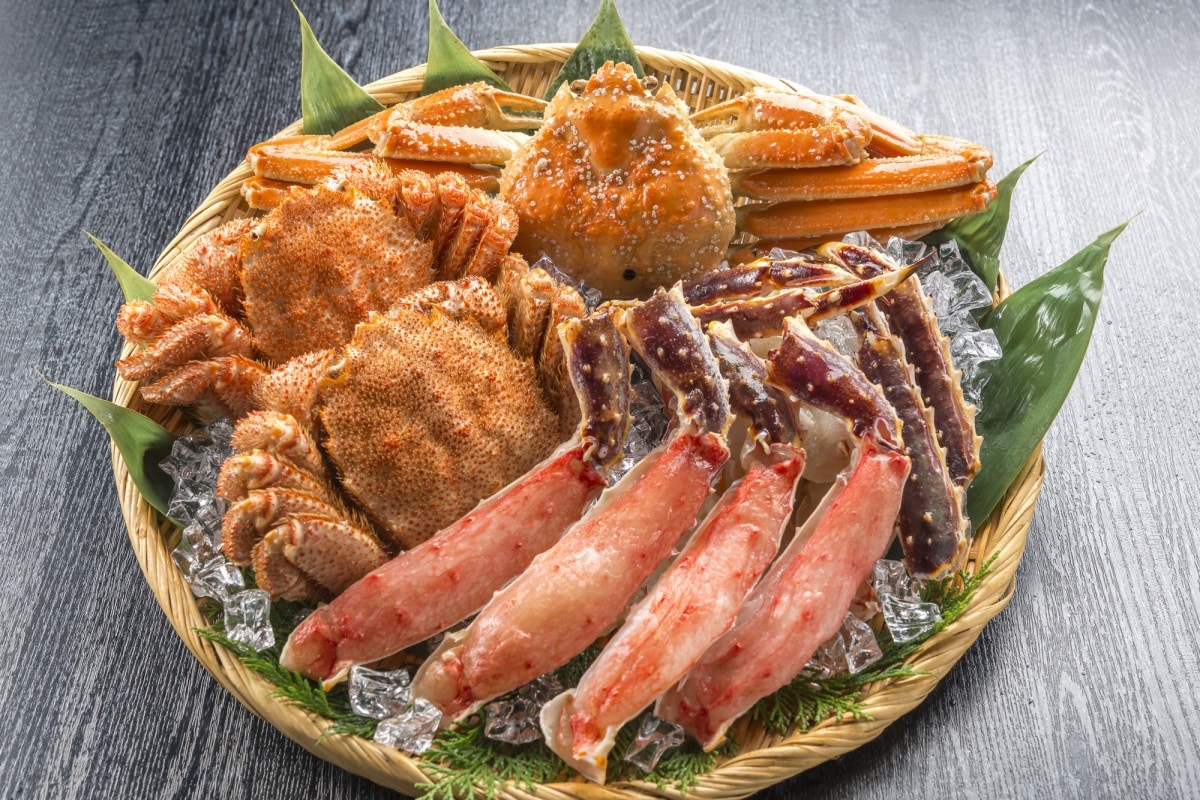
https://pixta.jp
Hokkaido is famous around Japan for its seafood. From crab to uni (sea urchin), octopus to oysters (not to mention the delicious sushi and sashimi), Sapporo has it all! The quality is indeed matched by the quantity, and the Susukino area in particular has enough seafood restaurants to last a lifetime! With such fresh, high quality seafood, you're almost bound to be spoiled regardless of where you go. But here are some of our top recommendations:
Ebi Kani Gassen: A fantastic seafood restaurant that specializes in succulent Hokkaido crab. All-you-can-eat courses start from ¥6,000, so bring your appetite!
Susukino Sushikin: A well-known restaurant for connoisseurs, Susukino Sushikin is an artisanal sushi restaurant located right next to Susukino Station. It requires a reservation, because the chef only prepares omakase courses that costs around ¥15,000, so it's best to avoid if you're on a budget.
Gotsubo: Gotsubo is a tiny seafood restaurant/street food stall where the chefs have mastered the art of cooking shellfish. The oysters are often regarded as some of the best in the city, and with good reason. This is a delicious, cheap alternative that definitely delivers some serious bang for your buck.
2. Ganso Ramen Yokocho
Sapporo's Ramen Yokocho is the largest ramen alleyway in Japan, with 17 shops and stalls lining its tight, confined area. Ramen, gyoza and Sapporo beer are all the stars of the show here, but there are a couple of specialities that are too good to be missed. The acclaimed Sapporo-style ramen with seafood and beansprouts is delicious, and the super popular miso, butter and corn ramen is particularly indulgent. You can also find vegetarian options as well, so be sure to ask! A stroll through this umami-filled alleyway provides an experience that is quintessentially Japanese, and should not be missed by any ramen fan!
3. Soup Curry
Sapporo is the birthplace of this dish, and the name says it all—a curry-flavored soup, with meat and vegetables swimming in the delicious broth. The base of the soup is a French-style brown stock generally made from slow-boiling beef and pork bones with chicken, onion, ginger and herbs, before adding an array of spices including coriander, cumin and curry powder. For those who like it super spicy, you often get the option of upping the heat to make your dish pack a real punch.
Soup curry can be found all over the city, but again Susukino is probably your best bet. Garaku is one of the most popular soup curry restaurants and the proof is in the curry, which boasts and impressive 21 spices! My recommendation is the pork belly soup curry, accompanied by rice and melted cheese. It is decadent and filling, and when they have to roll you out of the restaurant, you'll thank me!
4. Genghis Khan
Lamb and mutton are widely eaten in Sapporo, and are a staple of many restaurant menus. Genghis Khan (jingisukan・ジンギスカン) usually refers to a grilled lamb or mutton dish that is cooked at your table on a convex-shaped grill plate—this shape allows the juices from the meat to drip to the edges where the vegetables are lying in wait to soak them up. Rumor has it that the dish developed its name because lamb was thought to be the preferred meat of Mongolian soldiers, and the shape of the skillet is meant to mimic that of the soldiers helmets. The aforementioned Sapporo Brewery biergarten specializes in Genghis Khan mutton and lamb. Combine their rich meat and seasonal vegetables a fresh mug of Sapporo ale, and you have one of the best dining experiences that Sapporo has to offer.
5. Soft Cream
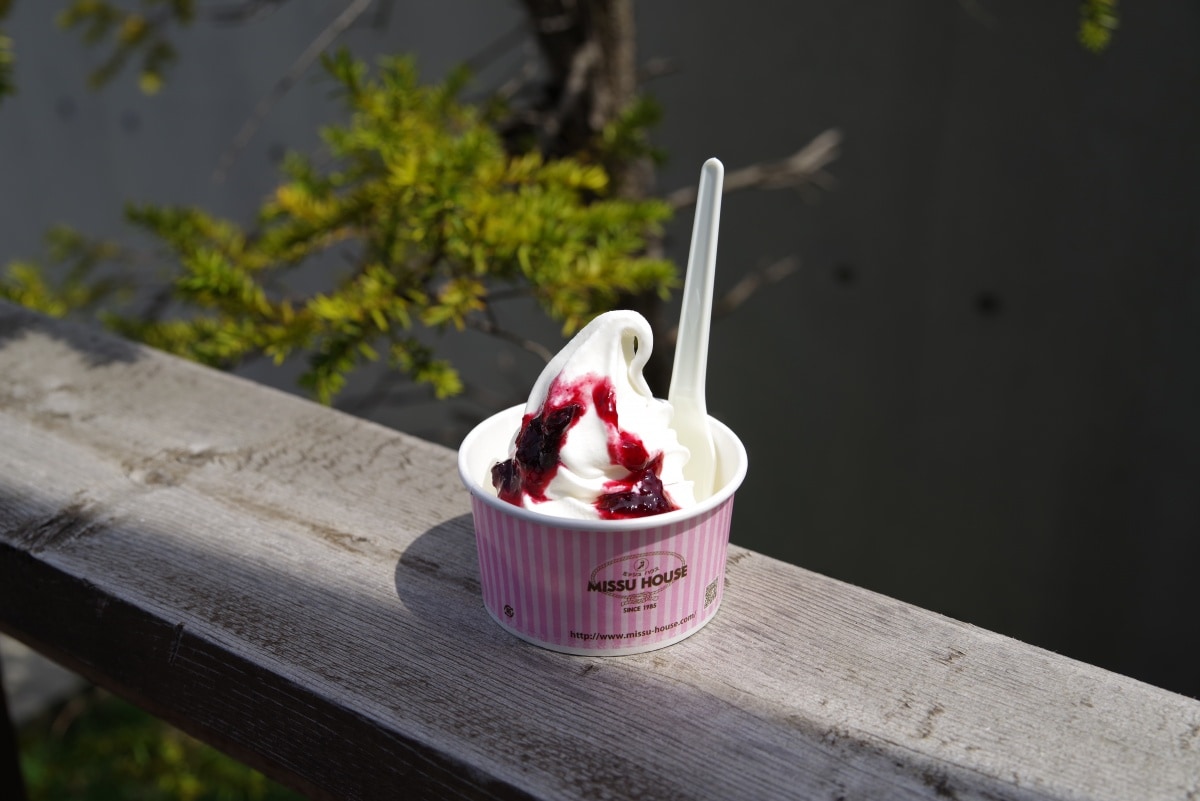
https://www.flickr.com/photos/tsukacyi/26788879305/in/photolist-a2gKM5-p9LpRg-TFVTnW-S6fAHT-GPf1vp-8DehER-nnDLT1-JpSGYU-JPK1ZJ-JYUVuK-7rZcz8-BjPvqk-toTn8p-TJTgNe-tog4RY-topC3X-tCwh6S-sJ2ntx-HY5WMe-J5xqbD-d6hqhE-K8JxEX-x8mXSQ-x8n5PC-uACpmN-uSJN8f-N8acCL-ue
Time to switch from savory to sweet! Soft cream is Sapporo's answer to soft-serve ice cream, and one of Japan's most beloved desserts. Hokkaido is Japan's leading milk and dairy producer, which naturally lends itself to incredible ice cream. With such high quality dairy so readily available (a bit of a rarity in Japan), soft cream can be purchased at pretty much any outlet that serves dessert in Sapporo.
But, if you like your ice cream to come with a creative twist, Milk Mura (literally "Milk Village") in Susukino might just be what you're looking for. With decor reminiscent of a '50s American diner (combined with a carnival), Milk Mura is as sweet on the eyes as it is on the tooth!
How to Get Around Sapporo
Japan Railways
The JR Sapporo Station is the largest Japan Railways hub in Hokkaido, and serves about 90,000 passengers a day. There are three JR lines at Sapporo Station—the Hakodate Main Line, the Chitose Line and the Sassho Line. Depending on how you get to Sapporo (more on that in a moment), the most important lines will be either the Hakodate Main Line, which connects Hakodate Station and Sapporo Station, or the Chitose Line, which goes to the New Chitose Airport. Please note that unlike the Metro or Streetcar, these lines are eligible for use of the JR Pass.
Metro
Sapporo has two metro lines—the Namboku Line, which runs from Asabu to Makomanai, and the Toho Line, which runs from Sakaemachi to Fukuzumi. These (along with the Sapporo Streetcar) are your best way to navigate the city, as they stop at some of the most popular downtown areas like Susukino and Odori. They're also quite affordable—One-Day Tickets for unlimited rides are only ¥830, and they also offer discounted weekend tickets for Saturdays, Sundays and national holidays for ¥520. Compared to busier cities like Tokyo or Kyoto, the metro trains are rather quiet, and (most pleasantly) not nearly as full.
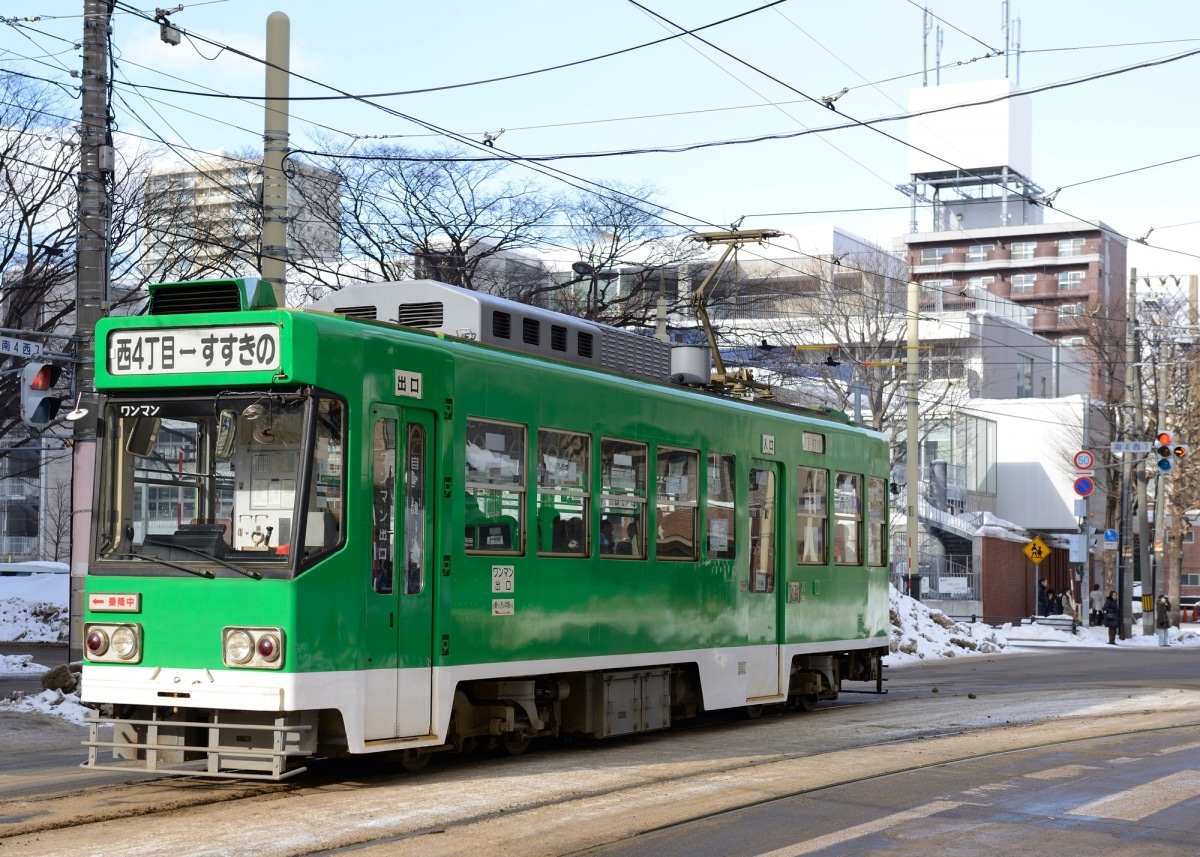
https://pixta.jp
Sapporo Streetcar
The Sapporo Streetcar (known as the shiden・市電) is a tram network that has been operating in Sapporo in some capacity since 1909! Presently, all stations serviced by the Streetcar are located in the Chuo ward, which means it's a very convenient way to get around downtown, especially when the weather is chillier. The fare is usually ¥200, but they also offer One_Day Passes for unlimited rides on Saturdays, Sundays and national holidays for ¥360. Sapporo is one of the few cities in Japan that utilizes this adorably retro mode of transportation, so don't miss the opportunity to hop on!
Buses
Buses are also commonplace in Sapporo, and become very useful if you want to visit outlying areas. The routes can be somewhat confusing to figure out, so it pays to plan ahead. The buses are generally pretty cheap (around ¥200 one-way), and JR buses are eligible for use with a JR Pass!
Extra Note
Generally speaking, trains and buses suspend operations between 12 a.m. and 6 a.m. If you're out at night and need to get back to your lodgings, your best bet will be a taxi. While they are readily available in downtown areas like Susukino, they're considerably more expensive than public transportation, especially after the trains stop.
It's also worth noting that popular IC cards like PASMO and Suica can be used in Sapporo. There is a local card, the SAPICA—provided by Sapporo Municipal Transportation—that can be used on the city's subway lines, buses and the streetcar.
For a detailed breakdown of fares and a timetable for the Namboku and Tozai lines, check here.
How to Get to Sapporo
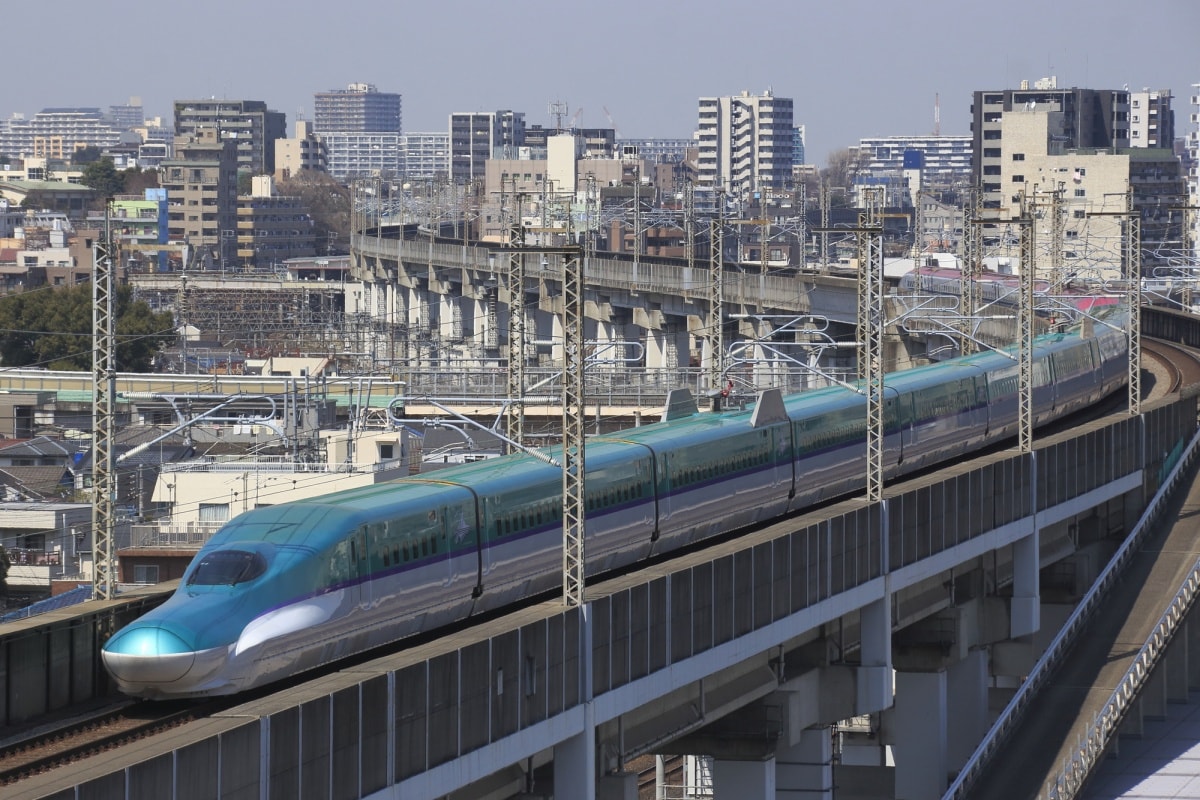
https://pixta.jp
By Shinkansen
The Hokkaido Shinkansen opened in March 2016, and links up with northern Japan's Tohoku Shinkansen lines via the undersea Seikan Tunnel. From Tokyo Station, the trip to Sapporo takes about eight hours. The bullet train from Tokyo to Shin-Hakodate-Hokuto Station takes a little over four hours. From there, a transfer to the Hokuto or Super Hokuto limited express train. A one-way trip will cost about ¥26,820—fortunately for international visitors, the entire route is covered by the JR Pass! What's more, regional JR Passes that service the South Hokkaido area are due to go on sale January 5, 2018.
By Plane
Sapporo's New Chitose Airport is an international hub for air travel in Hokkaido, and services numerous daily domestic flights to and from airports around Japan. Depending on the time of year (and time of booking), you can get a round-trip from Tokyo's Narita or Haneda airports for as cheap as ¥10,000. Flights from international airports are more expensive, but if you want to start a trip to Japan from the north, it's a very real possibility!
By Bus
While we usually recommend highway buses as a great way to save money when traveling domestically, the range of highway buses that service Sapporo are quite limited, and require you to be in Hokkaido anyway. That said, a trip from Hakodate to Sapporo takes about 5.5 hours, and costs about ¥4,000.
By Boat
MOL Ferry Co. operates ferries from Oarai (in Ibaraki Prefecture) to Tomakomai, a city on the southern coast of Hokkaido. The journey takes about 18 hours one-way, and passenger fare can range from ¥11,830 for a "casual room" to ¥30,340 for a "deluxe room" depending on the time of year. From Tomakomai, the JR Chitose Line to Sapporo takes a little over an hour, and costs about ¥1,100.
The Taiheiyo Ferry covers routes from Sendai (in Miyagi Prefecture) to Tomakomai, as well as Nagoya (in Aichi Prefecture) to Tomakomai. The journey from Sendai takes about 15 hours one-way, and passenger fares start at ¥9,300, but can escalate significantly depending on time of year and choice of cabin. The trip from Nagoya takes about 40 hours one-way, and includes a stopover in Sendai. Although the journey is considerably longer, passenger fare starts at ¥11,900.
Sapporo Local Tips
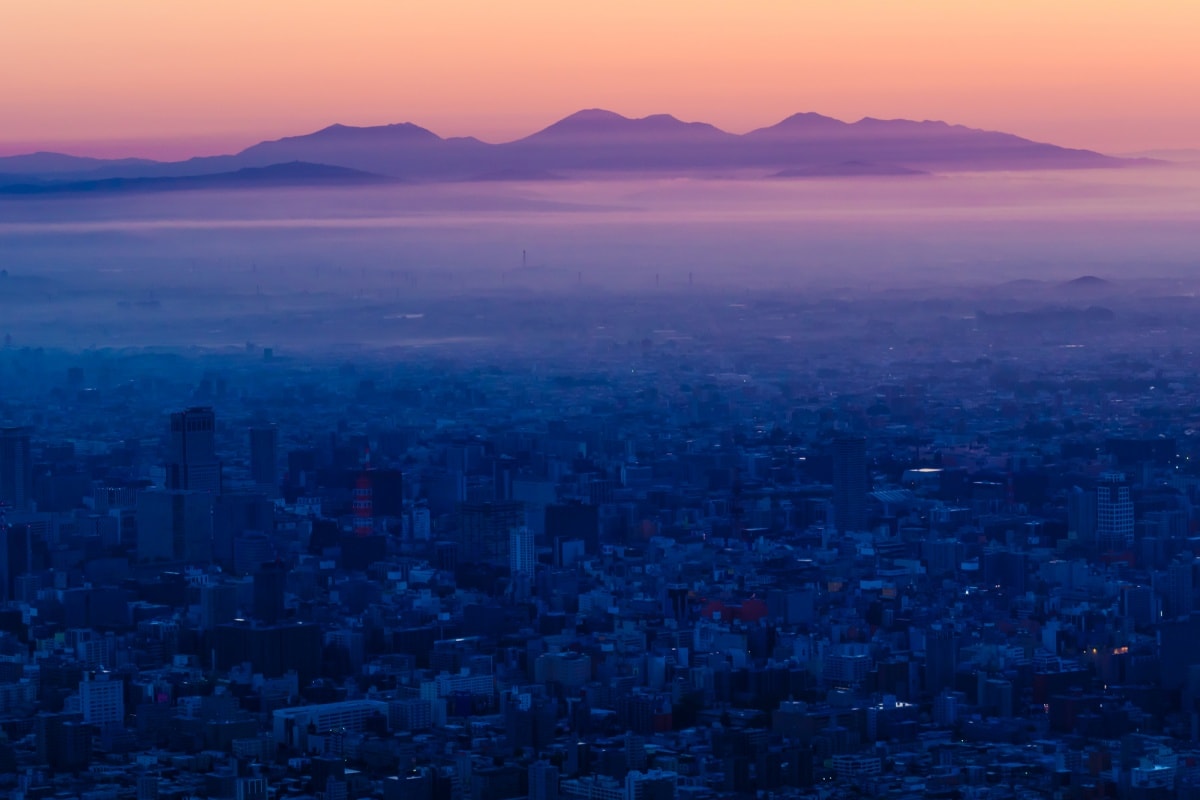
https://pixta.jp
Here are some extra tips and recommendations for visitors to Sapporo:
1. Depending on the season, Sapporo is a great walking city and has beautiful parks. Odori Park is located in the heart of the city and is a great backdrop for a photo opportunity, regardless of the time of year. For an incredible bird's-eye view, visit the Sapporo TV Tower observation deck. It's ¥720 well spent!
2. If you like whiskey or enjoy a good cocktail, check out The Long Bar in Susukino. They have a huge selection of whisky from all over the world and do a fantastic tiramisu inspired cocktail—not to mention the ultra-chic interior design. If you have a little extra time, take an excursion to the Nikka Whisky Yoichi Distillery!
3. Besides the Snow Festival, there are a variety of other festivals that take place throughout the year in Sapporo. These range from flower shows to beer festivals to seasonal illuminations and more. For more information, click here.
4. Hokkaido has a unique landscape and culture unlike anywhere else in Japan, and is practically begging to be explored! If you have some time, visit some of its beautiful national parks. It's also home to some truly gorgeous hot springs, some of which aren't too far from Sapporo itself.


